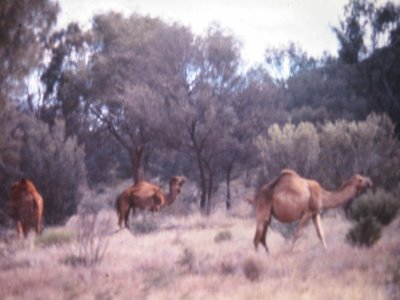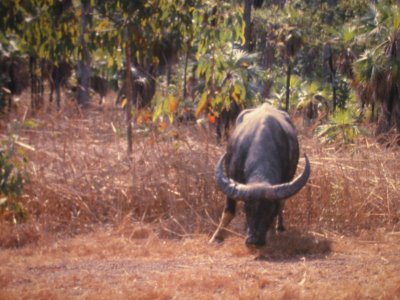
This is George, an inmate at Steve Irwins Australian Zoo, he is about
16 feet long, and probably won't grow much bigger now.
Steve can have them all to himself as far as I'm concerned, few animals
are better equipped for killing than the Crocodile.
Click on photos to enbiggen.
 The cane toad was imported to help our sugar cane farmers eradicate
The cane toad was imported to help our sugar cane farmers eradicate Feral goats had grown to such numbers in some areas that they were being
Feral goats had grown to such numbers in some areas that they were being Camels and their handlers from Afghanistan were introduced as beasts of
Camels and their handlers from Afghanistan were introduced as beasts of Another intrduced species that for a short time was a beast of burden here.
Another intrduced species that for a short time was a beast of burden here. This fellow isn't an introduced species, nor is he particularally nasty, he is a
This fellow isn't an introduced species, nor is he particularally nasty, he is a
Platypus
![]() Platypuses are covered with three layers of thick brown fur.
Platypuses are covered with three layers of thick brown fur.
![]() Platypuses live near streams and lakes in eastern parts of
Platypuses live near streams and lakes in eastern parts of
![]() Platypuses eat worms and other small animals that live in the water.
Platypuses eat worms and other small animals that live in the water.

Platypuses live beside rivers, creeks and lakes in
Platypuses have webbed feet and a broad, flat tail about 12 centimetres long
that helps them swim. As they swim, platypuses close their ears and eyes.
They feel for food with their leathery bill, which has special nerves in it to
sense food. Platypuses are most often out looking for food before dawn and
for a few hours before sunset.
The platypus scoops up worms,  shrimp, insect larvae and other small
shrimp, insect larvae and other small
animals that live on the bottom of rivers, creeks and lakes. They store the
food in cheek pouches, and swim to the surface to eat.
When they eat food, platypuses crush it with tough, horny pads on their upper
and lower jaws. They don't have teeth.
A platypus' body can be up to 45 centimetres long. They can weigh up to
2.3 kilograms. Males are larger then females. Male platypuses also have a
sharp, hollow claw-like spur behind the ankles on its hind legs. The spurs are
connected to poison glands. Male platypuses may use them to protect
themselves from predators and to fight other male platypuses during
mating season.
 The platypus has webbed feet for swimming. On land, the webs turn back
The platypus has webbed feet for swimming. On land, the webs turn back
to uncover claws on the feet which it uses to dig a long burrow in the banks
of rivers and creeks. Some burrows can be as long 25 metres. Each platypus
has its own burrow. Females build a nest of grass and leaves in a chamber at
the end of their nesting burrows when it is time to lay eggs.
 Here a "Joey" pokes his head from mom's pouch to investigate what she is
Here a "Joey" pokes his head from mom's pouch to investigate what she is Echidnas, these were taken at Steve Irwin's Australia Zoo, I have a couple of
Echidnas, these were taken at Steve Irwin's Australia Zoo, I have a couple of This little lizard goes by the name of "The Thorny Devil" which is something of
This little lizard goes by the name of "The Thorny Devil" which is something of The Wombat is another of the fairly common animals in Australia, but as with
The Wombat is another of the fairly common animals in Australia, but as with
My blog is worth $5,080.86.
How much is your blog worth?